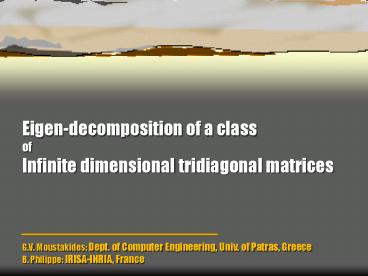Eigen-decomposition of a class of Infinite dimensional tridiagonal matrices PowerPoint PPT Presentation
Title: Eigen-decomposition of a class of Infinite dimensional tridiagonal matrices
1
Eigen-decomposition of a classofInfinite
dimensional tridiagonal matrices
G.V. Moustakides Dept. of Computer Engineering,
Univ. of Patras, GreeceB. Philippe IRISA-INRIA,
France
2
Outline
- Definition of the problem.
- From finite to infinite dimensions.
- Reduction of the problem to a finite
dimensional d.e. and eigen-decomposition
problem, using Fourier transform. - Numerical aspects regarding the solution of the
d.e. and the computation of the final (infinite
dimensional) eigenvectors. - Conclusion.
3
Definition of the problem
4
Eigen-decomposition Eigenvalues There is an
infinite number. Eigenvectors There is an
infinite number and each eigenvector
is of infinite size.
Goal To reduce the infinite dimensional
eigen-decomposition problem into a
finite one.
5
From finite to infinite dimensions
QK has dimensions (2K1)N ?(2K1)N, therefore
we have (2K1)N eigenvalue-eigenvector
pairs. Typical values N 100-1000, K 5-10.
6
QK has dimensions (2K1)N ?(2K1)N?i(k) has
dimensions (2K1)N ?1.k -K,,K, i 1,,N.
7
Consider now the infinite dimensional problem by
letting K ? ?
A?i (k,l1) (DlrI)?i (k,l) At?i (k,l-1)
?i(k)?i (k,l)
A?i (k,l1) D?i (k,l) At?i (k,l-1) (?i(k)
-lr)?i (k,l)
8
Reduction to finite dimensions
A?i(k,l1)D?i(k,l)At?i(k,l-1)
(?i(k)-lr)?i(k,l) A,D N?N?i(k,l) N?1i1,,N,
k,l -?,,?
A?i(n1)(D-?iI)?i(n)At?i(n-1) -nr?i(n)
9
A?i(n1)(D-?iI)?i(n)At?i(n-1) -nr?i(n)
?i , ?i(n), i1,,N, 0 ? ?i? r
10
Fourier Transform
Let , x(-2), x(-1), x(0), x(1), x(2), be a
real sequence. Then we define its Fourier
Transform as
11
A?i(n1)(D-?iI)?i(n)At?i(n-1) -rn?i(n)
12
We need ?i and ?i(0) to solve it.
?i(?) as being the Fourier transform of a
(vector) sequence isnecessarily periodic with
period 2?.
13
Theorem
Consider the following linear system of d.e.
14
(No Transcript)
15
Steps to obtain (?i ,?i (n)), i1,,N
- Compute the transition matrix ?(?) from the d.e.
- Find the eigenvalue-eigenvector pairs ?i,
?i(0) of
- Form the desired eigenvalue-FT(eigenvector)
pairs as
- Use Inverse Fourier Transform to recover the
final infinite eigenvector ?i(n) from ?i(?).
16
Numerical aspects
- Numerical solution of the d.e.
- Eigen-decomposition of ?(2?).
- Computation of the Inverse Fourier Transform of
?i(?) where
17
Numerical solution of the d.e.
One can show that ?(?) is unitary, therefore any
numerical solution should respect this structure.
A possible scheme is
18
(No Transcript)
19
Pade 1, 3 step intgr.
Pade 1, 1 step intgr.
Pade 2, 1 step intgr.
Pade 2, 3 step intgr.
20
Eigen-decomposition of ?(2?)
Since ?(2?) is unitary there are special
eigen-decomposition algorithms that require lower
computational complexity than the corresponding
algorithm for the general case.
From this problem we obtain the pairs ?i, ?i(0),
i1,,N.
Using the solution ?(?) of the differential
equation we can compute the Discrete Fourier
Transform of the eigenvectors
Notice that we obtain a sampled version of the
required Fourier transform.
21
Inverting the Fourier Transform
Let , x(-2), x(-1), x(0), x(1), x(2), with
Fourier Transform
22
Inverce discrete Fourier Transform
Complexity O(M 2). For M2m popular Fast
Fourier Transform (FFT).Complexity O(M log(M)).
Apply Inverse Discrete Fourier Transform to
?i(?n), this will yield the desired vectors
?i(n). If only a small number of ?i(n) is
significant, then we apply Inverse Discrete
Fourier Transform only to a subset of the vectors
?i(?n) produced by the solution of the d.e.
23
Conclusion
- We have presented as special infinite
dimensional eigen- decomposition problem. - With the help of the Fourier Transform this
problem was transformed into a d.e. followed
by an eigen-decomposition both of finite size. - We presented numerical techniques that
efficiently solve all subproblems of the
proposed solution.
24
Questions please ?

